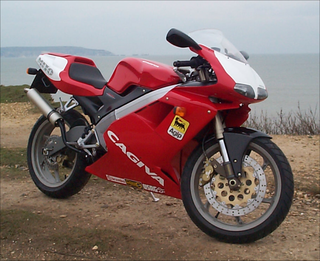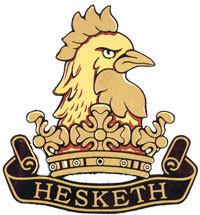
The Norton Motorcycle Company is a brand of motorcycles headquartered in Solihull, West Midlands,, England. For some years around 1990, the rights to use the name on motorcycles was owned by North American financiers.
Triumph Engineering Co Ltd was a British motorcycle manufacturing company, based originally in Coventry and then in Meriden. A new company, Triumph Motorcycles Ltd, based in Hinckley, gained the name rights after the end of the company in the 1980s and is now one of the world's major motorcycle manufacturers.

MV Agusta is a high end motorcycle manufacturer founded by Count Domenico Agusta on 19 January 1945 as one of the branches of the Agusta aircraft company near Milan in Cascina Costa, Italy. The abbreviation MV stands for Meccanica (mechanics) Verghera, the hamlet where the first MVs were made. The modern headquarters and main production facilities are located in Varese, Italy on the shore of Lake Varese.

Hesketh Racing was a Formula One constructor from the United Kingdom, which competed from 1973 to 1978. The team competed in 52 World Championship Grands Prix, winning one and achieving eight further podium finishes. Its best placing in the World Constructors' Championship was fourth in 1975. Hesketh gave James Hunt his Formula One debut, and he brought the team most of its success. Alan Jones also began his Formula One career in a privately entered Hesketh.

The Triumph Rocket III is a three-cylinder motorcycle made by Triumph Motorcycles Ltd. At 2,294 cc (140.0 cu in) it had the largest-displacement engine of any production motorcycle until 2019 when Triumph released the Triumph Rocket 3.

Matchless is one of the oldest marques of British motorcycles, manufactured in Plumstead, London, between 1899 and 1966. A wide range of models were produced under the Matchless name, ranging from small two-strokes to 750 cc four-stroke twins. Matchless had a long history of racing success; a Matchless ridden by Charlie Collier won the first single-cylinder race in the first Isle of Man TT in 1907.
Thomas Alexander Fermor-Hesketh, 3rd Baron Hesketh, KBE, PC is a British peer and UK Independence Party politician.

SV.VM was an Italian motorcycle manufacturer founded in 1971 by Piero Sironi and Fausto Vergani. Based in Milan, Italy, SWM manufactured Observed Trials, Enduro, Motocross and off-road motorcycles in the 1970s and 1980s. They started with small capacity Sachs engined enduro bikes and began making Rotax engined trials bikes in 1977. The other main manufacturers at this time included Fantic Motor, Bultaco and Montesa.

Česká zbrojovka is a Czech company producing forklifts Desta and components for the automobile industry, it is former firearms manufacturer, also known for making ČZ motorcycles. ČZ was established as a branch of the Škoda Works Armament in Strakonice, Czechoslovakia in September 1919.

Sachs Bikes International Company Limited is a German-based motorcycle manufacturer, founded in 1886 in Schweinfurt as Schweinfurter Präzisions-Kugellagerwerke Fichtel & Sachs, formerly known as Fichtel & Sachs, Mannesmann Sachs and later just Sachs.

The L-twin is a naturally aspirated two-cylinder petrol engine by Ducati. It uses a 90-degree layout and 270-degree firing order and is mounted with one cylinder horizontal.

The Ducati 851 is a 90° V-twin fully faired sport bike with liquid cooling and four valve heads. It was produced by Ducati between 1987 and 1992, when it was succeeded by the Ducati 888.

The Cagiva Mito is a small-engined Cagiva sports motorcycle. The powerplant consists of a two-stroke 125 cubic centimetres (7.6 cu in) single-cylinder engine.
The history of the motorcycle begins in the second half of the 19th century. Motorcycles are descended from the "safety bicycle," a bicycle with front and rear wheels of the same size and a pedal crank mechanism to drive the rear wheel. Despite some early landmarks in its development, the motorcycle lacks a rigid pedigree that can be traced back to a single idea or machine. Instead, the idea seems to have occurred to numerous engineers and inventors around Europe at around the same time.
Greeves Motorcycles was a British motorcycle manufacturer founded by Bert Greeves which produced a range of road machines, and later competition mounts for observed trials, scrambles and road racing. The original company produced motorcycles from 1952, funded by a contract with the Ministry of Pensions for their Invacar, a three-wheeler for disabled drivers.

Triumph Motorcycles Ltd is the largest UK-owned motorcycle manufacturer, established in 1983 by John Bloor after the original company Triumph Engineering went into receivership. The new company, initially called Bonneville Coventry Ltd, continued Triumph's lineage of motorcycle production since 1902. They have major manufacturing facilities in Thailand.
The Hesketh V1000 is a 992 cc (60.5 cu in) OHC V-twin motorcycle with 4 valves per cylinder. It was originally designed and built by Hesketh Motorcycles in Daventry, Northamptonshire. Sales proved disappointing as the motorcycle was expensive and, at 86 bhp, it was somewhat underpowered given its hefty dry weight of 244 kg (538 lb).
Broom Development Engineering is a British motorcycle manufacturer, and provides research and development services to the automotive and aerospace industries. Established in 1982 by engineer, Hesketh test rider and motorcycle racer Mick Broom, the company is based at Turweston Airfield near Brackley, Northamptonshire not far from the Silverstone racing circuit and has continued to improve the Hesketh V1000 engine and frame performance as well as updating earlier motorcycles to the latest specification. It produced each year about a dozen new V1000 EN10 motorcycles which were the V1000 with oil cooling improvements including an oil radiator to cool the rear cylinder. It has also produced fifty Hesketh Vampire tourers to customer specifications. Mick Broom put the Hesketh business up for sale in September 2008. The Hesketh motorcycle side of Broom Development Engineering was taken over by Mr Paul Sleeman who relocated the business south of London and intends to continue the improvements to the present models, with back-up and spares to present Hesketh owners and in time introduce new models.
Allen Norton is a defunct British company that supplied replicas of 350 and 500 cc Norton Manx road racing motorcycles. The company was run by Bernie Allen in Great Bedwyn, near Marlborough, Wiltshire.















